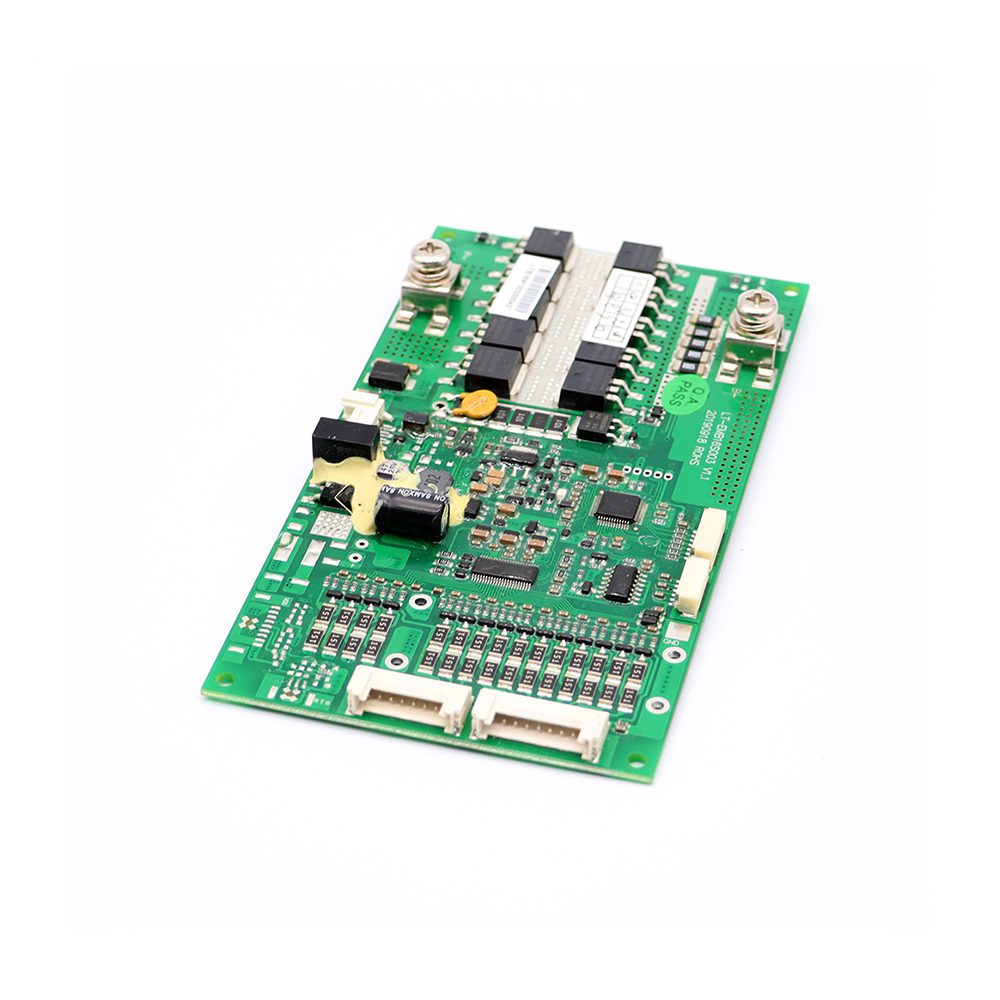What is a BMS(Battery Management System)?
A lithium battery protection board, also known as a battery management system (BMS), is an essential component in lithium-ion batteries. It is responsible for monitoring and protecting the battery from overcharging, overdischarging, and overcurrent conditions, ensuring the safe and efficient operation of the battery.
What are the main components?
A lithium battery protection board is an electronic circuit board used to protect lithium batteries. It is primarily composed of electronic circuits and can accurately monitor the voltage of the battery cells and the current of the charging and discharging circuits in the range of -40°C to +85°C. It controls the on/off state of the current circuit in a timely manner. The main components of a lithium battery protection board include a control IC, MOS switches, resistors, capacitors, and some auxiliary devices. The control IC is responsible for controlling the MOS switches to achieve charging and discharging control of the lithium battery. The MOS switches control the on/off state of the current circuit, while resistors, capacitors, and other components play a role in circuit protection and filtering.
How to distinguish the quality of a protection board?
To determine the quality of a protection board, you can consider the following aspects:
- Check the appearance of the protection board, including whether the circuit board is damaged, whether the components are complete, and whether the soldering quality is good.
- Test the performance of the protection board, including whether the voltage, current, and other parameters meet the requirements, and perform performance tests under various working conditions.
- Inspect the material quality of the protection board, including the brand, specifications, and quality level of key components such as ICs and MOS switches.
- Understand the manufacturer’s production process and quality assurance system, including the process flow, quality control standards, and quality testing equipment.
- Check relevant certifications and qualifications, including electronic product certifications such as CE and UL, as well as certifications obtained by the manufacturer.
What are the key Parameters of a BMS?
The key parameters of a Battery Management System (BMS) may vary depending on the specific application and battery technology involved. However, here are some commonly considered key parameters:
- Voltage Monitoring: The BMS monitors the battery voltage to ensure that it stays within safe operating limits. This includes monitoring the individual cell voltages in a battery pack and the total pack voltage.
- Current Monitoring: The BMS measures the current flowing into and out of the battery. This helps in managing the charging and discharging processes and prevents overcurrent conditions.
- State of Charge (SOC): The BMS estimates the remaining capacity or state of charge of the battery. It provides information about how much energy is left in the battery, allowing for accurate battery management and usage.
- State of Health (SOH): The BMS assesses the overall health and performance of the battery. It monitors factors such as capacity degradation, internal resistance, and aging effects to determine the battery’s remaining useful life.
- Temperature Monitoring: The BMS measures the temperature of the battery cells to prevent overheating or extreme temperature conditions that can affect battery performance and safety.
- Cell Balancing: For battery packs with multiple cells, the BMS ensures that the voltage levels among individual cells are balanced. This helps to equalize cell voltages and optimize the overall performance and longevity of the battery pack.
- Fault Detection and Protection: The BMS detects and protects against various faults, such as overvoltage, undervoltage, overcurrent, short circuits, and excessive temperature. It triggers appropriate safety measures to prevent damage to the battery and ensure user safety.
- Communication and Data Logging: Many BMS systems include communication interfaces to enable data exchange with external devices, such as chargers or vehicle management systems. They can also log and store battery data for analysis and diagnostics.

How to choose a right charger for my lithium ion battery?
When choosing a charger for your lithium-ion battery, there are several factors to consider. Here are some guidelines to help you make an informed decision:
- Battery Chemistry and Voltage: Determine the specific chemistry and voltage requirements of your lithium-ion battery. Different lithium-ion chemistries (e.g., Li-ion, LiPo) have different charging characteristics and voltage specifications. Ensure that the charger you select is compatible with your battery’s chemistry and voltage.
- Capacity and Current Rating: Consider the capacity (mAh or Ah) of your battery and its recommended charging current. The charger should have a current rating within the acceptable range for your battery. Charging at a higher current than recommended can potentially damage the battery, while charging at a lower current may result in longer charging times.
- Charging Method: Decide whether you require a constant current (CC), constant voltage (CV), or a combination of both charging method. Most lithium-ion batteries require a CC-CV charging profile, where the charger initially provides a constant current and then switches to a constant voltage when the battery reaches a certain voltage level. Ensure that the charger you choose supports the appropriate charging method for your battery.
- Safety Features: Look for chargers with built-in safety features, such as overcharge protection, short circuit protection, and overheat protection. These features help prevent damage to the battery and ensure safe charging.
- Charge Indicator and Monitoring: Consider whether you prefer a charger with a display or indicators that show the charging status and battery capacity. Some chargers also offer additional features like voltage monitoring, internal resistance measurement, or capacity testing.
- Brand and Quality: Choose chargers from reputable brands known for their quality and reliability. Look for chargers that comply with relevant safety standards and certifications, such as CE (Conformité Européene) or UL (Underwriters Laboratories).
- User Reviews and Recommendations: Read user reviews and seek recommendations from trusted sources or online communities to gather feedback on the performance and reliability of specific chargers.
- Price and Warranty: Consider your budget and compare prices among different chargers. However, prioritize quality and safety over price. Additionally, check for warranty information provided by the manufacturer to ensure support and possible replacements if needed.










